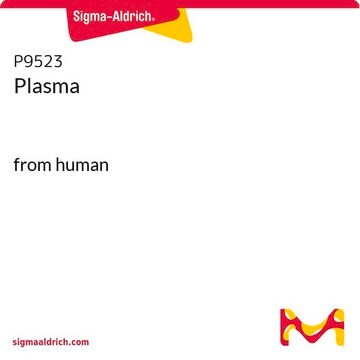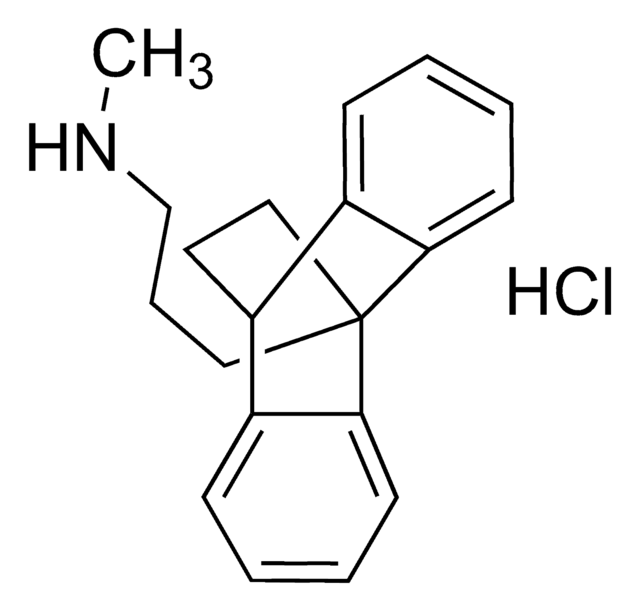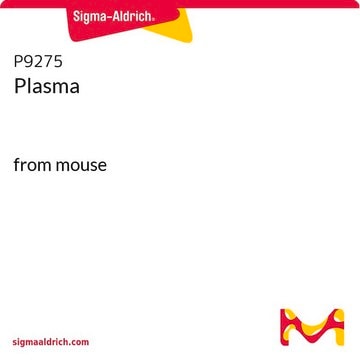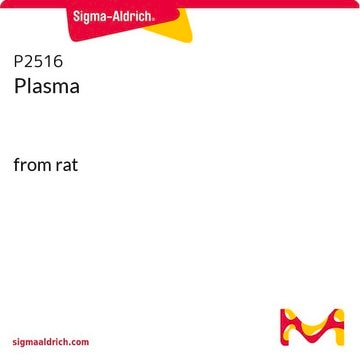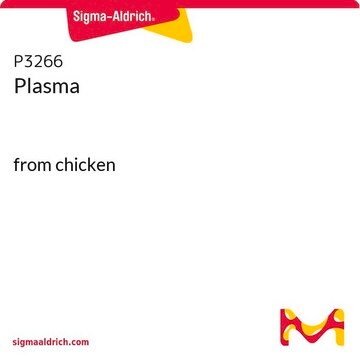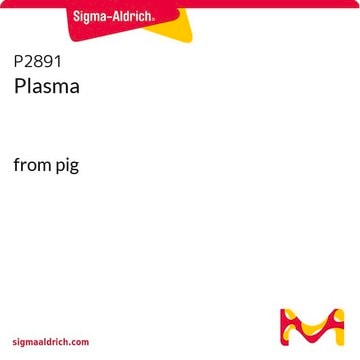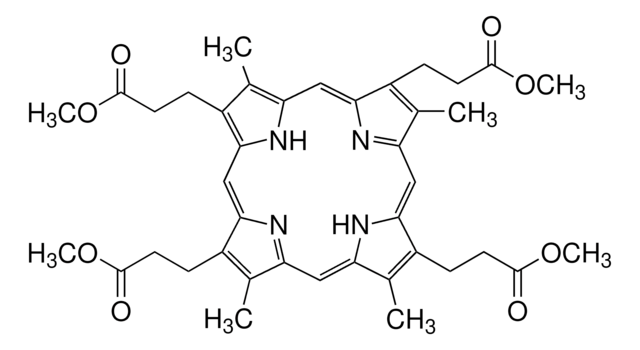P4639
Plasma
from bovine
Synonyme(s) :
Plasma citraté
Se connecterpour consulter vos tarifs contractuels et ceux de votre entreprise/organisme
About This Item
Produits recommandés
Source biologique
bovine
Niveau de qualité
Forme
powder
Contient
3.8% trisodium citrate as anticoagulant
Température de stockage
2-8°C
Vous recherchez des produits similaires ? Visite Guide de comparaison des produits
Description générale
Plasma is the liquid part of the blood and lymphatic fluid, which makes up about half of its volume. Plasma is devoid of cells and, unlike serum, has not clotted. Some of the more common proteins found in plasma are albumin and prealbumin, α1-acid glycoprotein, transferrin, lipoproteins (HDL, LDL, and VLDL), immunoglobulins, complement proteins, and coagulation proteins (thrombin, plasminogin, and fibrinogen). Citrated plasma contains citrate (3.8% trisodium citrate) as an anticoagulant.
Plasma contains a variety of proteins with diverse functions. The primary functions of the plasma proteins include the maintenance of colloid osmotic pressure, pH, and electrolyte balance; the transport of metal ions, fatty acids, steroids, hormones, and drugs to various organs of the body; use as a source for amino acids for tissue nourishment; hemostasis and the prevention of thrombosis; the regulation of cellular activity and function through hormone signaling; and defense against invasion through the actions of antibodies and complement components.
Plasma contains a variety of proteins with diverse functions. The primary functions of the plasma proteins include the maintenance of colloid osmotic pressure, pH, and electrolyte balance; the transport of metal ions, fatty acids, steroids, hormones, and drugs to various organs of the body; use as a source for amino acids for tissue nourishment; hemostasis and the prevention of thrombosis; the regulation of cellular activity and function through hormone signaling; and defense against invasion through the actions of antibodies and complement components.
Notes préparatoires
This product is prepared from pooled bovine blood. It is prepared from whole blood that is collected with anticoagulants (9:1) and centrifuged to remove cells and cellular debris. It contains 3.8% trisodium citrate as an anticoagulant. It is tested for clotting, which indicates that the clotting factors in the product are active. However, it is not analyzed to determine whether other enzymes present are native or denatured.
Whole blood collected with anticoagulants (9:1), pooled, and centrifuged. The resulting plasma is 0.45 μm filtered and lyophilized from the indicated volumes.
Code de la classe de stockage
11 - Combustible Solids
Classe de danger pour l'eau (WGK)
WGK 3
Point d'éclair (°F)
Not applicable
Point d'éclair (°C)
Not applicable
Certificats d'analyse (COA)
Recherchez un Certificats d'analyse (COA) en saisissant le numéro de lot du produit. Les numéros de lot figurent sur l'étiquette du produit après les mots "Lot" ou "Batch".
Déjà en possession de ce produit ?
Retrouvez la documentation relative aux produits que vous avez récemment achetés dans la Bibliothèque de documents.
Les clients ont également consulté
Gareth LuTheryn et al.
Frontiers in cellular and infection microbiology, 12, 956808-956808 (2022-08-23)
Bacterial biofilms are a major and ongoing concern for public health, featuring both inherited genetic resistance traits and a conferred innate tolerance to traditional antibiotic therapies. Consequently, there is a growing need for novel methods of drug delivery, to increase
Venus Baghalabadi et al.
Proteomes, 9(4) (2021-11-30)
Conventional solvent-based precipitation makes it challenging to obtain a high recovery of low mass peptides. However, we previously demonstrated that the inclusion of salt ions, specifically ZnSO4, together with high concentrations of acetone, maximizes the recovery of peptides generated from
Achmad Syarif Hidayat et al.
Sensors (Basel, Switzerland), 21(14) (2021-07-25)
This work describes a new method for determining K+ concentration, [K+], in blood plasma using a smartphone with a custom-built optical attachment. The method is based on turbidity measurement of blood plasma solutions in the presence of sodium tetraphenylborate, a
Reece J Goiffon et al.
Nature communications, 6, 6271-6271 (2015-02-11)
Myeloperoxidase (MPO) is a circulating cardiovascular disease (CVD) biomarker used to estimate clinical risk and patient prognosis. Current enzyme-linked immunosorbent assays (ELISA) for MPO concentration are costly and time-intensive. Here we report a novel bioluminescence assay, designated MPO activity on
Müge Andaç
Artificial cells, nanomedicine, and biotechnology, 43(2), 133-139 (2013-10-31)
A new approach to albumin removal for proteome studies involving human plasma samples was presented with dye affinity poly glycidyl methacrylate (PGMA) nanobeads in an average size of 45 nm. The specific surface area of PGMA nanobeads was calculated as
Notre équipe de scientifiques dispose d'une expérience dans tous les secteurs de la recherche, notamment en sciences de la vie, science des matériaux, synthèse chimique, chromatographie, analyse et dans de nombreux autres domaines..
Contacter notre Service technique